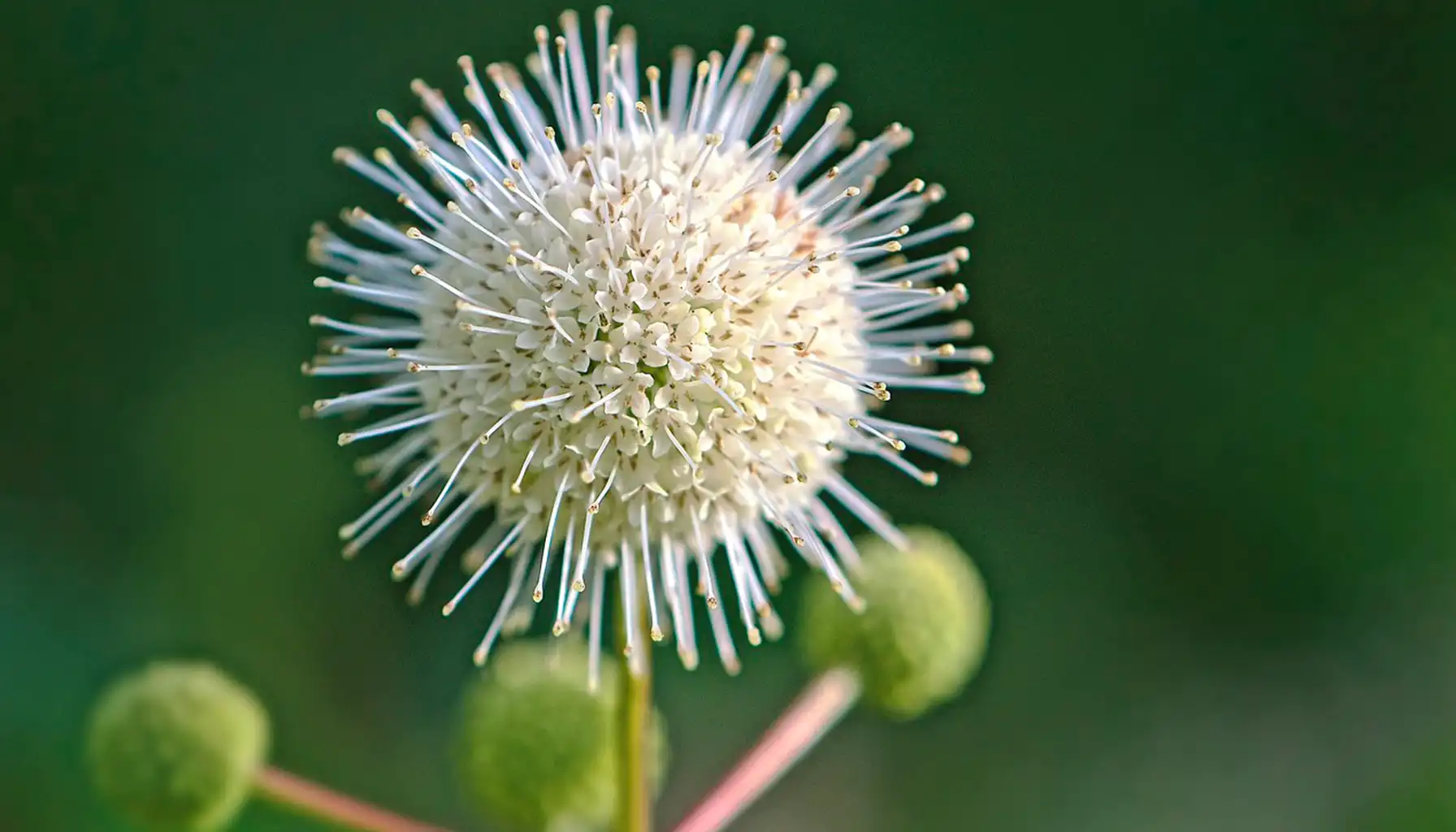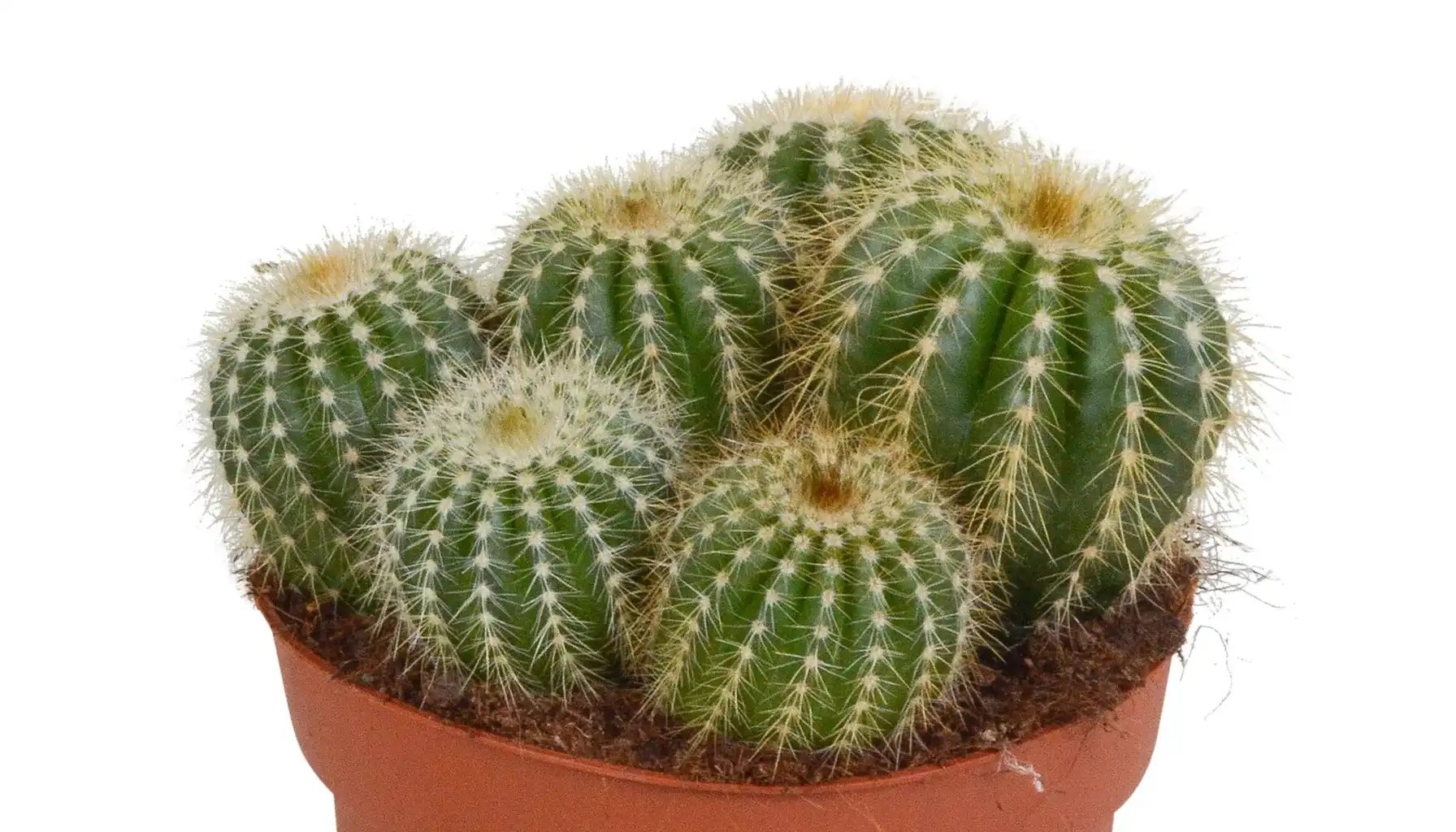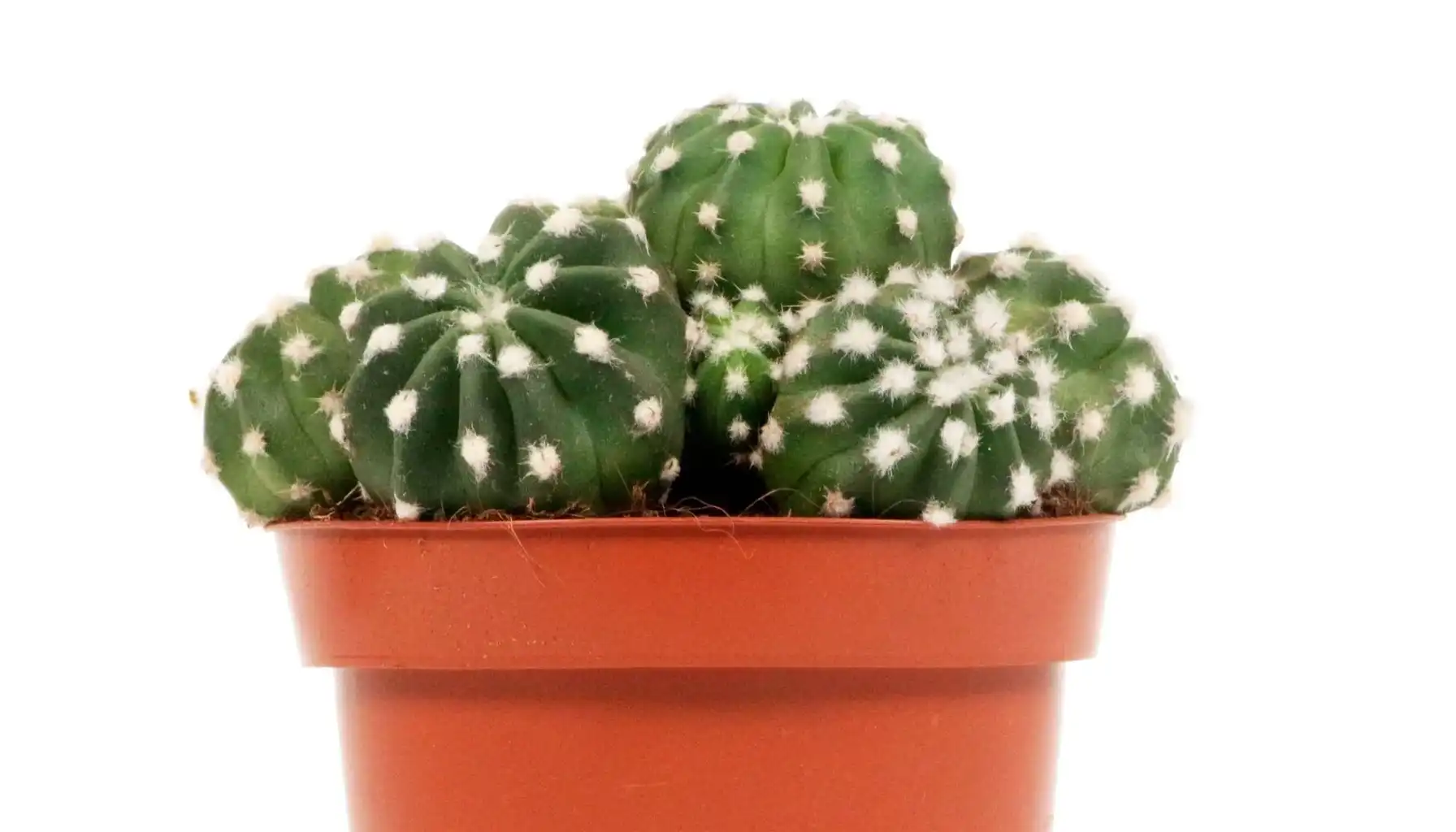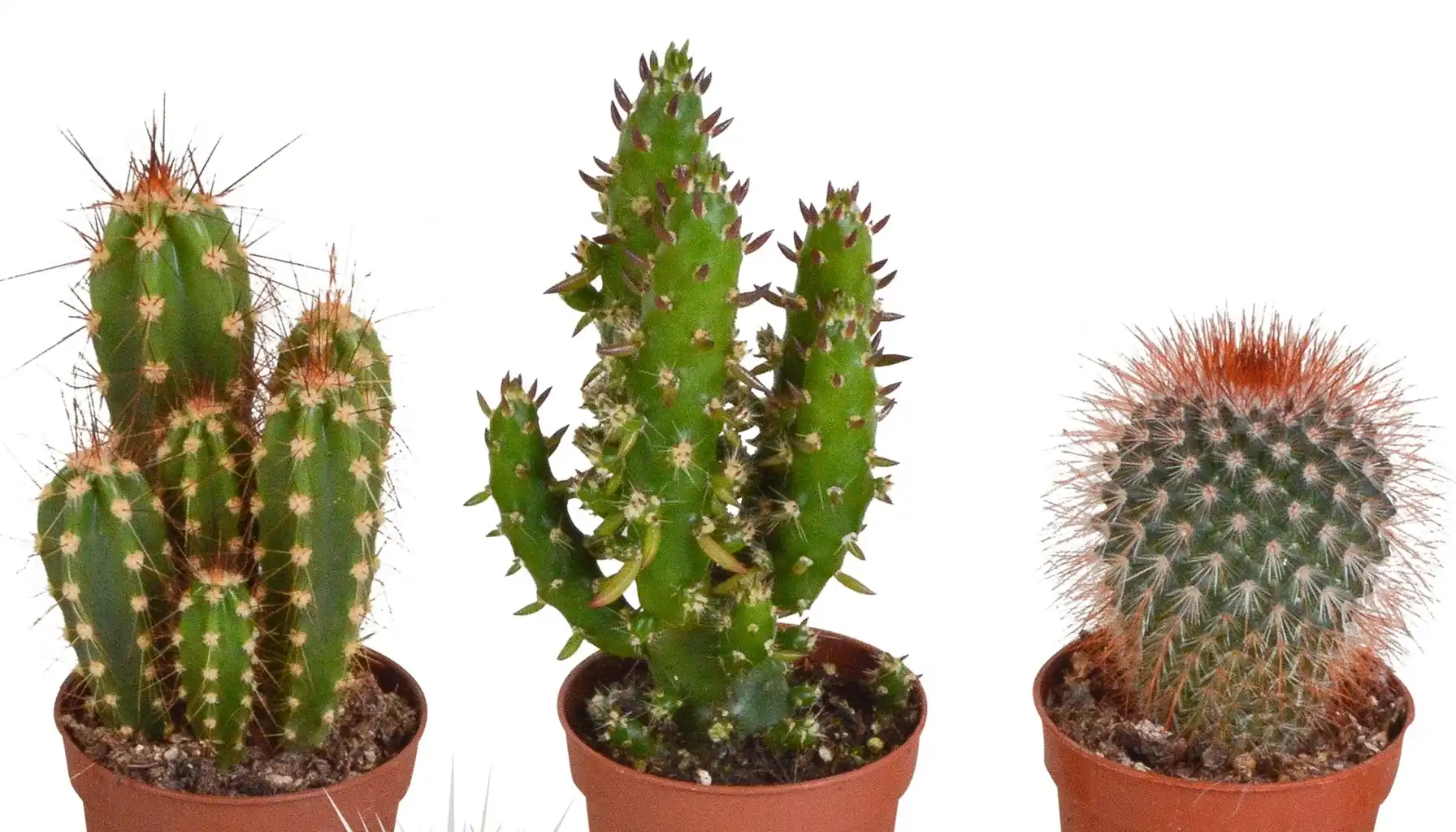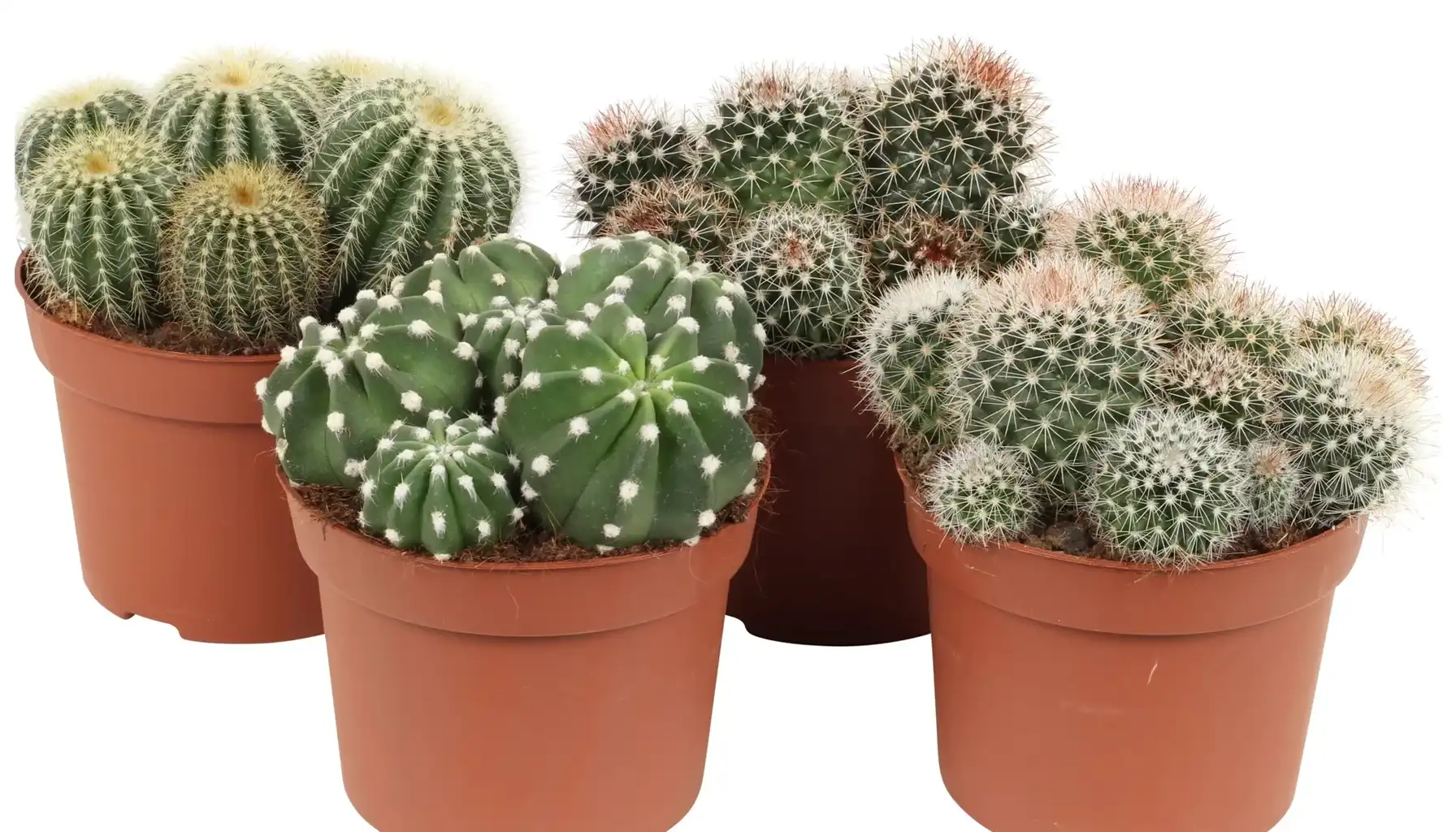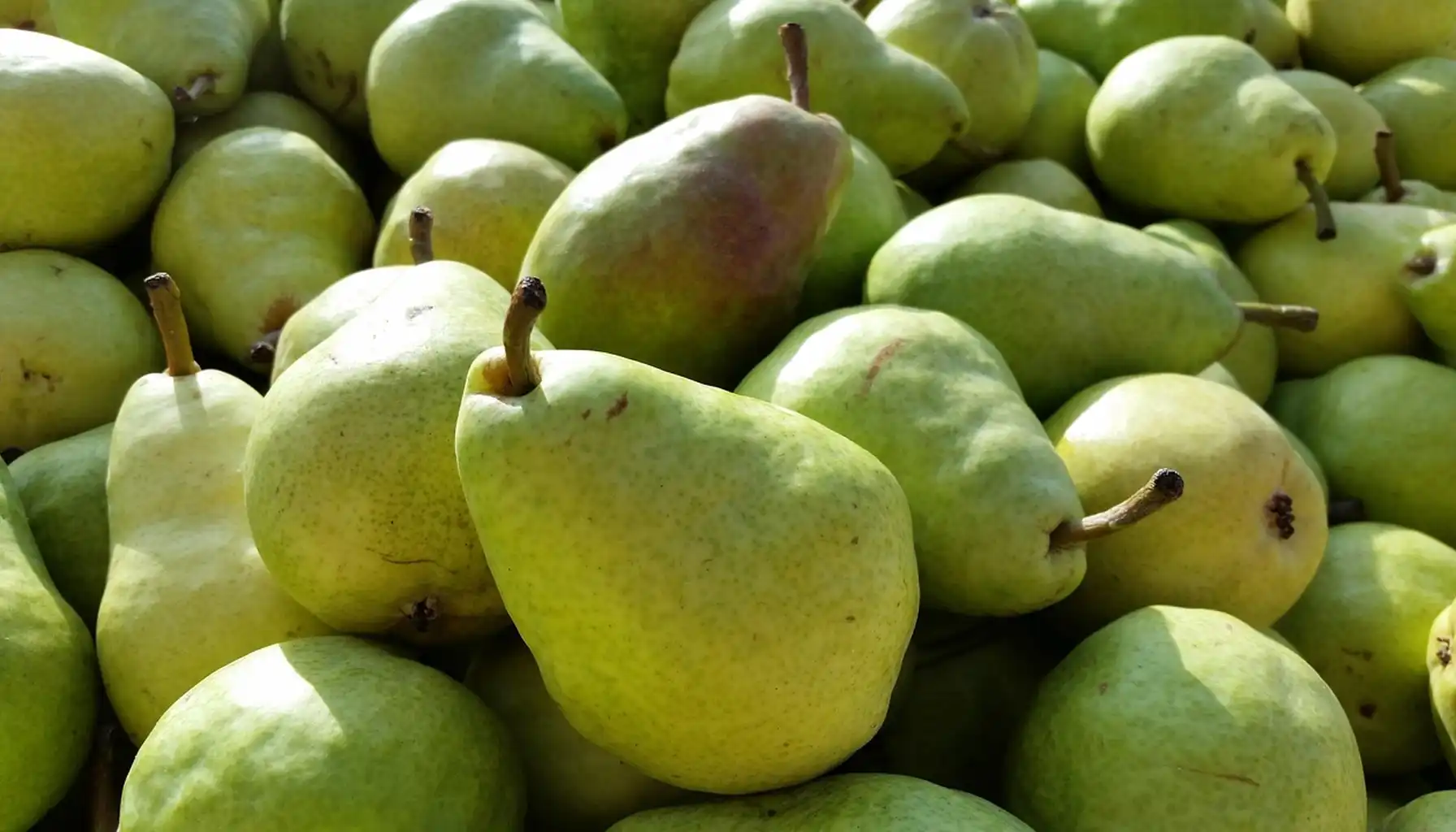The cactus ball group is from genera like Parodia, Notocactus, and Gymnocalycium. They all have compact size, grow both indoors and outdoors, fitting easily on sunny windowsills, patio pots, or rock gardens.
These cacti have a unique globe-like form, which stays neat even as they age. Many develop blooms in spring or summer, with types like the sunny golden ball cactus, the ruby cactus with its vivid red top. The plants may stay small and spherical or elongate into short columns over time.
Ball cacti are ideal for beginners. They need little more than bright light, well-draining soil, and infrequent watering. Cacti have resistance to heat, drought, and pests, but it’s always good to check twice. Some diseases may not be obvious to the human eye right away. That’s why some use apps like a free plant identifier and check the online current condition of your plant.
What Is a Ball Cactus?
A round ball cactus is a succulent that stores water in its thick, ribbed stem. This way it survives in dry environments, because the plant minimizes surface area and reduces water loss.
Ball cacti are members of several genera, most notably Parodia and Gymnocalycium, and have tidy appearance and showy seasonal blooms. Typically covered in spines that are golden yellow to silver or white, each ball shaped cactus develops a unique texture and pattern.
Most varieties produce flowers from the crown in shades of yellow, red, orange, or pink. Many gardeners prefer small cacti species because they fit easily into pots, windowsills, and dish gardens.
With this manageable size, you can grow them indoors or in outdoor spaces like rockeries and desert-themed planters. Cacti are hardy, resilient, and tolerant of neglect if they have excellent drainage and plenty of sunlight.
Popular Species & Varieties
Succulents of any type are usually pretty bright, so there are many ball cactus types for any taste. Here are the most popular types of ball cactus:
The golden cactus (Parodia leninghausii), also called the lemon ball cactus. It has bright green stems covered in soft, golden spines. It begins as a globe and elongates into a column as it matures, eventually reaching 4 feet tall. In spring and early summer, it produces silky yellow ball cactus blooms from the crown, standing out against its sunny spines
The ruby ball cactus (Gymnocalycium mihanovichii) has red top grafted onto a green base. It stays small, rarely exceeding a few inches, and thrives in bright, indirect light
The scarlet ball cactus has fiery red ball cactus flowers; the silver ball cactus has pale-gray spines and a cooler tone, perfect for contrast in mixed plantings.
Collectors also enjoy miniature forms nicknamed the golf ball cactus and small ball cactus for their tidy growth habit.
Some decorative cultivars are marketed as color ball cactus selections, bred for unusual spine hues and flower shades
Common Name | Scientific Name | Height | Flower Color | Notes |
Scarlet Ball Cactus | Parodia haselbergii | 4–6 in | Scarlet red | Dense spines, showy flowers |
Golden | Parodia leninghausii | Up to 4 ft | Bright yellow | Fast grower, elongates with age, soft golden spines |
Lemon | Parodia leninghausii | 3–4 ft | Yellow | Easy to grow, loves sun |
Ruby | Gymnocalycium mihanovichii | 2–4 in | Red (grafted top) | Best indoors with indirect light |
Silver | Notocactus scopa | 6–8 in | Yellow | Silvery spines, compact habit |
Golf Cactus | Parodia ottonis | 4–6 in | Yellow | Rounded, ideal for containers |
Flowers & Blooming
The ball cactus flower blooms typically start from the crown, forming a halo of silky petals.
The golden and lemon cacti produce vibrant yellow blooms; the scarlet cacti have fiery red flowers. Some species, like Notocactus scopa, develop soft yellow or cream-colored blooms with delicate centers. The flowers usually open during daylight and close at night, lasting several days to a week.
To encourage abundant flowering, give your cactus a strong light: ideally, full sun for several hours daily, and a well-drained soil mix. During the active growing season (spring through early fall), water using the “soak and dry” method. Let the soil dry completely between waterings.
Avoid fertilizing too often; a light feeding once in spring with a diluted cactus fertilizer is enough to support bloom formation. Ball cacti typically begin flowering once they reach maturity, which may take two to three years depending on species and conditions.
Light, Temperature & Placement
They are one of those plants that grow in the desert. These succulents live in bright conditions with plenty of direct sunlight. Outdoors, place them where they receive at least 6 hours of full sun daily. Indoors, a south- or west-facing window works best. Gradually acclimate plants moved from indoors to outdoors to avoid sunburn.
The popular cactus with red ball on top, the Gymnocalycium mihanovichii grafted form, needs slightly gentler light. It prefers bright, indirect sunlight, as too much direct exposure can fade its color. Supplemental grow lights can help maintain brightness indoors.
Ball cacti like warm temperatures during the growing season, ideally between 65°F and 85°F (18–29°C). They tolerate short periods of higher heat if kept dry. In winter, cooler conditions around 50–60°F (10–15°C) encourage dormancy. Protect from frost, as most species are not hardy below 20°F (-6°C).
Setting | Light Exposure | Temperature Range | Notes |
Indoor (windowsill) | Bright, indirect to full sun | 65–80°F (18–27°C) | Rotate weekly for even growth |
Outdoor (garden/patio) | Full sun, 6+ hrs daily | 65–85°F (18–29°C) | Gradual acclimation to prevent sunburn |
Dormant period | Reduced light, dry soil | 50–60°F (10–15°C) | Do not overwater during winter rest |
Watering Routine
Like most desert succulents, they prefer the “soak and dry” method: thoroughly wet the soil, then let it dry completely before watering again. Overwatering is the most common cause of problems such as root rot.
The lemon ball likes it when its watered deeply but infrequently. During the active growing season (spring and summer), water about once every 1-2 weeks, adjusting based on temperature, light, and pot size. In very hot weather, monitor more often.
In fall and winter, the cactus enters dormancy and needs much less water, typically once every 3-4 weeks or less. Always check the soil before watering; if it feels damp, wait a few more days.
Season | Frequency | Notes |
Spring | Every 10–14 days | Active growth begins; increase gradually |
Summer | Every 7–10 days | Check dryness more often in heat; full watering each time |
Fall | Every 3–4 weeks | Reduce as growth slows; ensure full drying between cycles |
Winter | Minimal to none | Dormant phase; water lightly only if the soil becomes bone-dry |
Soil & Fertilizer
Proper soil is the base of ball cactus care. The plant needs an airy, fast-draining mix that prevents water from sitting around the roots. Ordinary garden soil holds too much moisture and can lead to compaction or root rot.
The ideal growing medium is slightly acidic to neutral (pH 6.0–7.0) and rich in mineral content. You can purchase a ready-made cactus or succulent mix, or create your own blend.
DIY Soil Mix
Fertilize once per year during active growth (spring or early summer) with a diluted cactus fertilizer: a balanced 5-10-5 or 10-10-10 formula at half strength. Apply only after watering to avoid burning the roots. Skip fertilizing in fall and winter while the cactus rests.
Propagation
Many species naturally produce small pups, or offsets, at the base of the parent plant. To propagate, gently twist or cut the offsets away using a knife. Let them callus (dry and form a protective layer) for 3-5 days in a warm, shaded spot before planting.
Once callused, place them in a shallow container filled with well-draining cactus soil. Water lightly after one week and keep in indirect light until roots form.
Seed propagation is an option too. Sow seeds on the surface of a moist cactus mix, press them gently into the soil, and cover with a thin layer of sand or grit. Maintain consistent warmth (70–80°F) and humidity until germination, which can take several weeks.
Common Issues
Problem | Likely Cause | Fix |
Soft or mushy stem | Overwatering, poor drainage | Let soil dry; repot in fast-draining mix; reduce watering |
Wrinkled appearance | Cactus stress ball. Underwatering, temperature stress | Water deeply; move to a stable, warm spot |
Pale, stretched shape | Insufficient light | Move to a brighter location; provide 6+ hours of sun |
Brown patches | Sunburn or heat shock | Provide gradual sun exposure; avoid hot afternoon rays |
No blooms | Low light or excess fertilizer | Increase sunlight; use diluted fertilizer once per season |
Design & Decorative Uses
Smaller forms, often nicknamed the ping pong ball cactus, fit into terrariums, geometric planters, or windowsill trays. They’re perfect for minimalist décor or office settings, requiring little space or maintenance.
Soft-spined species sometimes called the cotton ball cactus contrasts with stones and ceramic containers.
Group several in mixed pots with pebbles, sand layers, or driftwood accents for a desert-inspired design. Combine them with other succulents, like echeverias or haworthias.
Care Summary Table
Factor | Recommendation |
Light | Bright light; 6+ hours of full sun or strong indirect light indoors |
Watering | Use the “soak and dry” method; allow soil to dry fully between deep waterings |
Soil | Well-draining mix (sand + perlite + potting soil); slightly acidic (pH 6.0–7.0) |
Temperature | Ideal 65–85°F (18–29°C); cooler (50–60°F) during winter dormancy |
Fertilizer | Diluted cactus fertilizer once in spring; avoid feeding in fall/winter |
Humidity | Low; prefers dry air and good airflow |
Propagation | Offsets or seeds; let the offsets callus before planting |
Bloom Season | Spring to early summer; flowers appear at the crown |
Pests | Rare; watch for mealybugs or spider mites |
Hardiness | Zones 9–11; protect from frost |
Repotting | Every 2–3 years, refresh the soil and inspect the roots |
Conclusion
With well-draining soil, bright light, and careful watering, these plants can grow for years while maintaining their sculptural form.
Varieties like the golden, lemon, and ruby types have a wide palette of textures and colors, so you can create combinations or minimalist single-plant displays. They have drought tolerance and grow slowly, so they are easy companions in indoor and outdoor settings.
FAQs
How often should I water a cactus?
Water only when the soil is completely dry. In spring and summer, this usually means every 1–2 weeks. During fall and winter dormancy, reduce watering to once every 3–4 weeks or less.
Can a cactus bloom indoors?
Yes, with enough sunlight. Place it in a bright window or use a grow light. Mature plants in strong light often produce spring or summer flowers from the crown.
Why is my cactus turning soft or wrinkled?
Softness usually means overwatering, while wrinkles suggest dryness or temperature stress. Follow the soak-and-dry method and keep the plant in stable warmth.
What’s the red ball on top of some cacti?
That’s a grafted ruby ball cactus (Gymnocalycium mihanovichii), which lacks chlorophyll and must grow on another green cactus base.
How big does a cactus get?
Size depends on the species; many stay under 6 inches tall, taller types like Parodia leninghausii can reach up to 4 feet over time.
Do ball cacti need fertilizer?
A light feeding once a year in spring with diluted cactus fertilizer supports healthy growth and flowering.
Can I keep it outside year-round?
Only in frost-free zones (9–11). Elsewhere, move containers indoors before temperatures drop below 40°F (4°C).
Related AI Plant Finder Posts
